
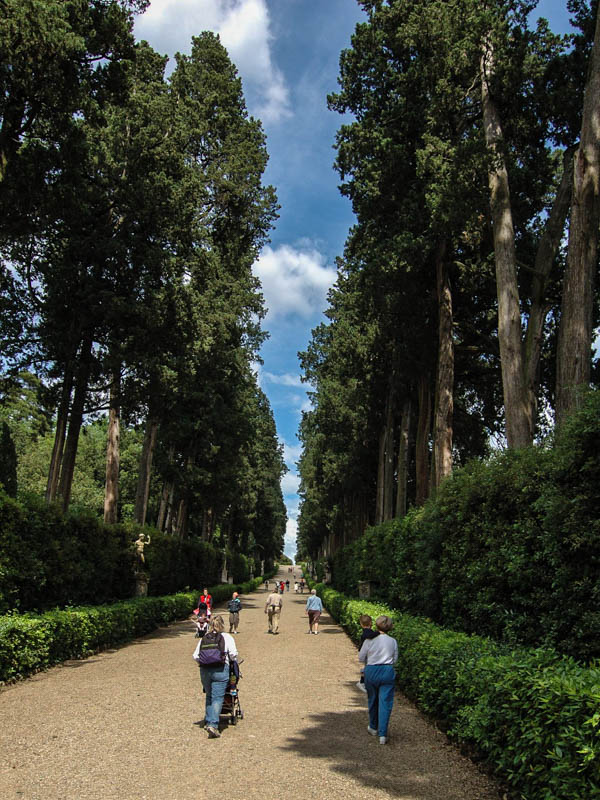
The statue-filled park behind the Pitti Palace is one of the earliest and finest Renaissance gardens, laid out mostly between 1549 and 1656 with box hedges in geometric patterns, groves of ilex, dozens of statues, and rows of cypress.
In 1766, it was opened to the Florentine public, who still come here with their families for Sunday-morning strolls.
Just above the entrance through the courtyard of the Palazzo Pitti is an oblong amphitheater, modeled on Roman circuses and constrcuted in 1630–35 by Giulio and Alfonso Parigi. In the middle is a granite basin from Rome's Baths of Caracalla and an Egyptian obelisk of Ramses II from Heliopolis.
But before the 17th century trasnformation, this spot was, in 1589, the setting for the wedding reception of Ferdinando de' Medici's marriage to Christine of Lorraine.
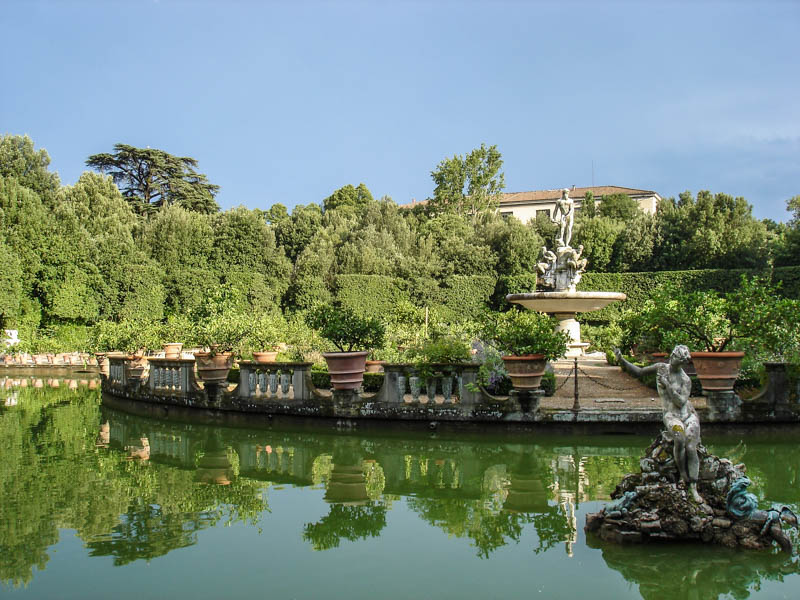
For the occasion, the Medici commissioned entertainment from Jacopo Peri and Ottavio Rinuccini.
The composers came up with the novel idea of setting a classical story (Dafne) to music and having actors sing the whole thing.
We now consider this the world's first opera. (Later, the duo collaborated on a follow-up hit Erudice, performed here in 1600; it's the first opera whose score has survived.)
A terrace above the amphitheater with three Roman-era statues lead to a path climbing to the Neptune Fountain (1571) by Stoldo Lorenzi.

From here, you can angle back to the left (north) to find the rococo Kaffehaus, used for parties in the age of the Grand Dukes and still offering bar service in summertime.
Return to the Neptune Fountain and head straight up to the top of the park, under the city walls andjust below the hulking Forte di Belvedere batlments off to your left.
The giant Giambologna statue of Abundance started as a portrait of Franceso I's wife, Giovanna of Austria, and was later reworked by Giambologna's student, Pietro Tacca into this allegorical figure. The reason it is so large is that it was originally supposed to perch atop a column on Piazza San Marco; it was placed here in 1636 by Giovanna's daugher, Maria de' Medici (better known as Queen Marie of France, wife of Henry IV and mother and regent to King Louis XIII).
Pause to drink in the city views, then turn right and continue to the very tip-top of the Boboli Gardens.Hard against the city walls you'll find the Giardino del Cavaliere, the Boboli's prettiest hidden corner. This tiny walled garden of box hedges and spring flowers offers private views over the wooded hills of Florence's outskirts. Also here is the faded pink building called the Casino del Cavaliere, once used for summer balls and today housing the Museo delle Porcellane tablewares collection.
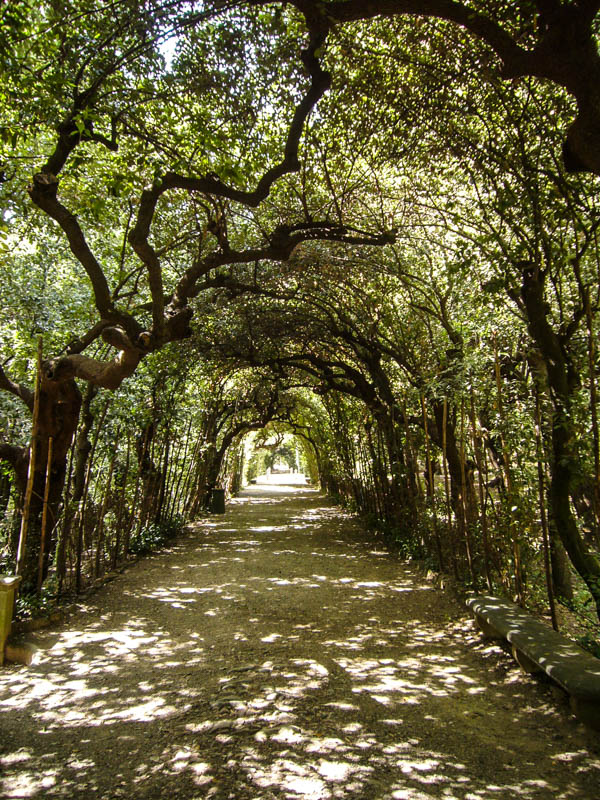
Back to the central Neptune Fountain.
Paths lead to the fountain's southwest to the wide, cypress-lined Viotollone, the main drag of the Boboli.
This gravel path leads steeply down west toward the park's Porta Romana gate, passing dozens of statues in niches (some ancient Roman; others baroque era) and lots of tiny paths curling out from both sides, many of them tunnels under arbors of trained ilex trees (holm oaks).
It's a nice area to get lost for a while; in fact, these side paths did once comprise a trip of lanyrintths, but these were destroyed when the curving paths were added in the 1830s.
The Viottolone leads, eventually, to the pond around the Isolotto, a rose-garden island created by the Parigi in 1612 and dominated by the Fountain of Oceanus carved by Gimabologna for Francesco I de' Medici 1578 (this is a replica; the original is now in the Bargello for safekeeping).
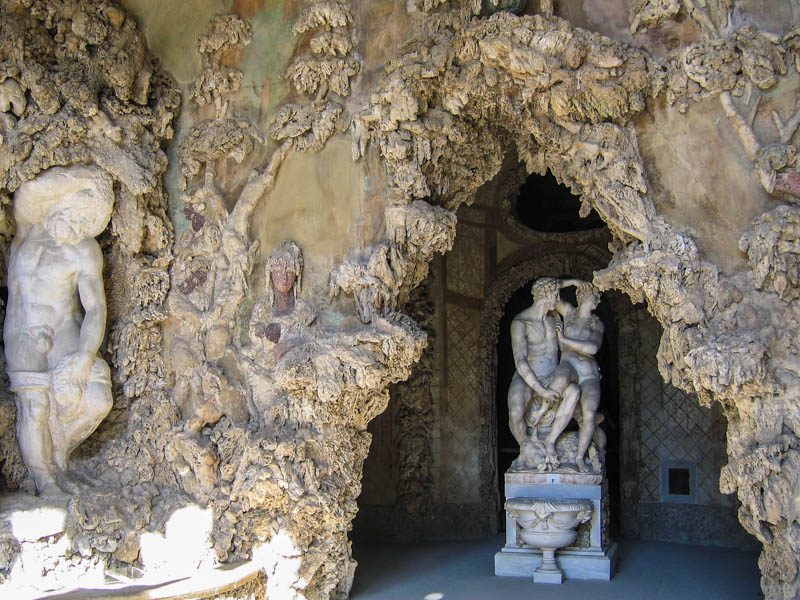
An English-style garden called the Hemicycle extends form here toeard the park's western gate.
At the northeast end of the park, down around the end of the Pitti Palace, are several fake caverns filled with statuary, attempting to invoke some vaguely classical sacred grotto.
The most famous, the Grotta Grande or Grotta di Buontalenti, was started by Giorgio Vasari in 1557, but finished by Bernardo Buontalenti between 1583 and 1593, dripping with phony stalactites (back in ducal times, it dripped with water, too, from hundreds of tiny jest and tubes) and set with statues by Baccio Bandinelli and frescoes by Bernardino Poccetti.
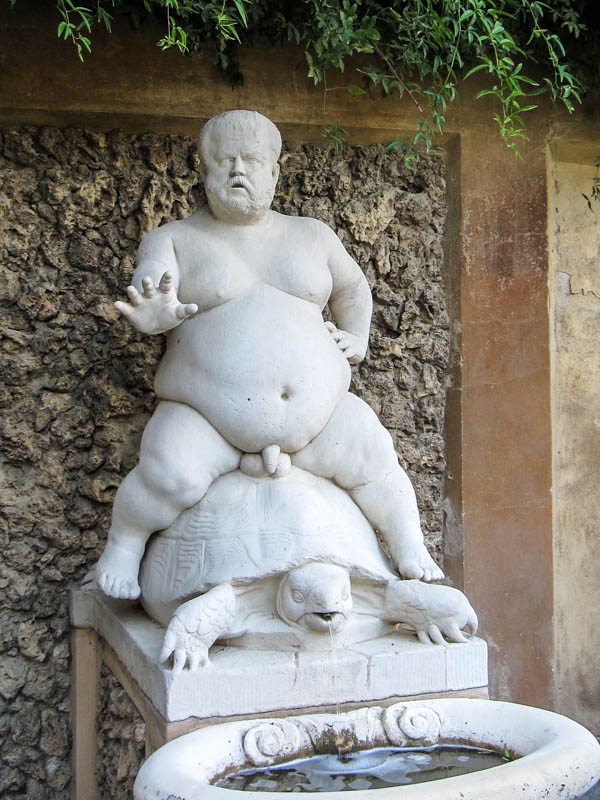
Cosimo I had Michelangelo's four unfinished Slave statues placed in each of the grotto's corners; they have long since been replaced by repilcas (the originals are safe in the Accademia.)
In the second chamber of the Grotto is a Paris and Helen marble grouping by Vincenzo de' Rossi.
In the third, tiny chamber of the grotto behind that are mosaic wall foutains and a central fountain with Giambologna's Mannerist Venus supported by satyrs.
Near the exit to the park is a Florentine postcard favorite, the Fontana di Bacco (Bacchus Fountain; 1560), a pudgy dwarf sitting atop a tortoise by Valerio Cioli. It's actually a portrait of Pietro Barbino, Cosimo I's potbellied dwarf court jester.
Piazza Pitti (cross the Ponte Vecchio and follow Via Guicciardini; you can't miss it)
tel. +39-055-238-8614
www.polomuseale.firenze.it
Tickets: Select Italy
Galleria Palatina, Appartamenti Reali, and Galleria d'Arte Moderna:
Tues–Sun 8:15am–6:50pm
Galleria del Costume, Museo degli Argenti, Boboli Gardens, and Museo delle Porcellane:*
Tues–Sun as follows:
Jun-Aug 8:15am–6:50pm (Boboli Gdns: to 7:30pm)
Apr-May, Sept-Oct 8:15am–6:30pm
[portions of Oct and Mar after/before switches daylight savings time: 8:15am–5:30pm]
Nov-Feb 8:15am–4:30pm
* Museo delle Porcellane closes 15 min. earlier
Museo delle Carrozze: Currently closed
(Pitti Palace is free the first Sunday of each month)
Tickets: Select Italy
Firenze Card: Yes
Bus: C3, D
Hop-on/hop-off: Pitti (A)
Planning your day: Budget at least two hours for a cursory visit of just the Galleria Palatina and Appartamenti Reali.
If you plan to venture into
the Boboli Gardens, give it another hour.
If you have only passing interest in the other museums, each will take about 20 minutes.
Note that the last entry for every museum or part of the Pitti complex is 1 hour before closing.
The major parts of the Pitti Palace complex (Galleria Palatina, Apartamenti Reali, Boboli Gardens, and Porcelain Museum) are covered by the Firenze Card—free admission, no waiting in line. » more
If all you're into is the art, you can get a ticket covering just the Galleria Palatina and Modern Art Gallery for €8.50.
If, however, you'd like to wander the rest of the collections (and gardens) as well, don't spend another €6 or €7 on the separate collective ticket. Instead, get the "biglietto cumulativo," an all-access pass for €11.50 that lets you into all the Pitti galleries, apartments, and gardens for three days.
Or just use the Firenze Card.
Take a guided tour of Palazzo Pitti with one of our partners:
Pitti Palace tours
Boboli Gardens toursWarning: The Pitti Palace seems to revel in closing a handful of its (lesser) museums for years at a time—lately, it seems to be the collection of fancy carriages in the Museo dell Carozze.
Just which ones will be closed at any given time and for how long works on some mysterious schedule I have yet to discern. Check before visiting if missing, say, the costume gallery or the porcelain museum will spoil your vacation.
Share this page
Search ReidsItaly.com
Piazza Pitti (cross the Ponte Vecchio and follow Via Guicciardini; you can't miss it)
tel. +39-055-238-8614
www.polomuseale.firenze.it
Tickets: Select Italy
Galleria Palatina, Appartamenti Rrali, and Galleria d'Arte Moderna:
Tues–Sun 8:15am–6:50pm
Galleria del Costume, Museo degli Argenti, Boboli Gardens, and Museo delle Porcellane:*
Tues–Sun as follows:
Jun-Aug 8:15am–6:50pm (Boboli Gdns: to 7:30pm)
Apr-May, Sept-Oct 8:15am–6:30pm
[portions of Oct and Mar after/before switches daylight savings time: 8:15am–5:30pm]
Nov-Feb 8:15am–4:30pm
* Museo delle Porcellane closes 15 min. earlier
Museo delle Carrozze: Currently closed
(Pitti Palace is free the first Sunday of each month)
Tickets: Select Italy
Firenze Card: Yes
Bus: C3, D
Hop-on/hop-off: Pitti (A)